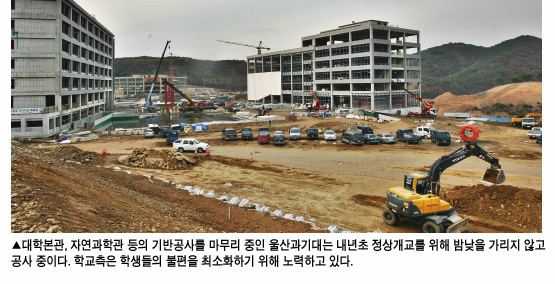Type Public Budget 152 million USD (2015) Academic staff 391 (2016) Mascot Uni(윤이) the Unicorn Motto First in Change | Established 2007 (2007) President Mooyoung Jung Administrative staff 288 (2016) Phone +82 52-217-0114 Founded 13 September 2007 | |
 | ||
Similar Daegu Gyeongbuk Institute o, KAIST, Gwangju Institute of Science a, Pohang University of Scienc, Seoul National University Profiles | ||
Ulsan national institute of science and technology
Ulsan National Institute of Science and Technology, simply referred to as UNIST (Hangul: 울산과학기술원; Hanja: 蔚山科學技術院; RR: Ulsan Gwahak Gisurwon), is one of the four public universities in South Korea which are dedicated to research in science and technology, along with KAIST, GIST, and DGIST. UNIST was founded in 2007 in response to growing demand for higher education in the Korean industrial capital of Ulsan, where world-renowned automotive (Hyundai Motor), shipbuilding (Hyundai Heavy Industries), petrochemical (SK Energy), and secondary cells industries are clustered. At the time of its foundation, UNIST was known for being the first national university in South Korea to be incorporated and thus administered by an independent board of trustees despite being funded by the central government. UNIST has the vision of becoming a world-leader in the advancement of science and technology for the prosperity of humankind. With strong support from central and local governments, UNIST aims to develop at least 10 competitive areas of research with the goal of being ranked top 10 globally by the year 2030. The strategies for reaching this goal include creative, interdisciplinary and global education and research.
Contents
- Ulsan national institute of science and technology
- History
- Academics
- Affiliated Research Centers
- Campus
- Note
- References
History
Despite the fact that Ulsan, with over 1.1 million residents, is an industrial powerhouse of South Korea with the highest GDP per capita among any region in the country, there only existed one university within the city limits, the University of Ulsan. The former president Roh Mu-hyun included the establishment of a national university in Ulsan as part of his campaigning platform and a discussion regarding the university began three years into his presidency along with the construction of a new high speed rail station, Ulsan Station, for the city.
The location of the campus was finalized in 2006 and in 2007, Moo Je Cho was selected as the first president of the new university. Cho appealed to the public that the school should be a science and technology oriented institute in order for the new school to find its niche and to take advantage of a possible synergetic effect resulting from a collaboration between the researchers and the local industry as seen in the case of Stanford University and Silicon Valley or KAIST and Daedeock Innopolis.
UNIST was established by the UNIST bill that was passed in 2007 by the request of the people and city of Ulsan. In 2009, UNIST opened its doors to welcome its first class of undergraduate students.
In March 2015, a new bill was passed in the national assembly recognizing UNIST as one of the four nationally funded research institutes in Korea. Besides changing the Korean name of the school from Ulsan Gwahak Gisurdae (울산과학기술대) to Ulsan Gwahak Gisurwon (울산과학기술원), the passage of this bill implied a new set of additional changes and benefits from the national government including but not limited to a greater emphasis on graduate education and the waiver of the alternative military service examination for its PhD students.
Academics
UNIST is a medium-sized, research oriented university that is rapidly shaping up to be one of the premier science and engineering institutions in the nation. Modeled after other prestigious universities around the world such as KAIST, MIT and HKUST the school employed three approaches that would set UNIST apart from other universities in Korea. First, despite being a national university of Korea, 100% of the courses at UNIST are taught in English and the school is actively seeking ways to recruit international students and professors. Second, all undergraduate students are required to pursue two areas of specializations called 'tracks'. The first track is roughly equivalent to a major and the second track is comparable to a minor at other universities. Third, UNIST has adopted the flipped learning approach in its classrooms in order to promote active student participation and mastery of the core subjects in science and engineering.
UNIST comprises 9 science and engineering schools, a business school, and the Division of General Studies (DGS) which oversees the school's first year undergraduate curriculum. In addition, there are several specialized graduate schools and research centers.
Affiliated Research Centers
- Center for Multidimensional Carbon Materials (Director Rodney Ruoff)
- Center for Soft and Living Matter (Director Steve Granick)
- Center for Genomic Integrity (Director Kyungjae Myung)
Campus
UNIST maintains a fully residential campus which contains a slew of consistently designed modern-looking buildings. Its location, Eonyang, is adjacent to the old Ulsan city and small mountains surround the whole campus. At the center of the campus, there sits a large man-made pond called Gamakmot, a popular destination for students who seek change of pace in the midst of their studies. The campus is also near the Bangudae Petroglyphs site which is known for containing the oldest depiction of whaling practices by humans. The campus can be easily accessed from other major cities in South Korea via KTX due to its close proximity to the Ulsan Station.
